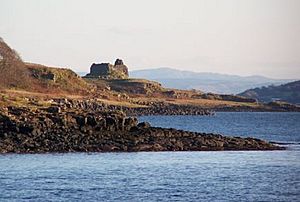Treaty of Westminster (1462) facts for kids

The Treaty of Westminster was an important agreement signed on 13 February 1462. It was made between Edward IV of England, who was from the House of York, and a powerful Scottish leader named John of Islay, Earl of Ross, who was also known as the Lord of the Isles.
This treaty had a big idea: if England managed to take over Scotland, the land north of the Firth of Forth (a large sea inlet) would be split. It would be given to the Lord of the Isles and another Scottish noble, the Earl of Douglas. They would then rule these lands under the English king. The Earl of Douglas would also get to rule the southern part of Scotland.
Contents
Why the Treaty Happened
Scotland's Troubles with England
At this time, the young Scottish king, James III of Scotland, was still a child. His country was involved in the Wars of the Roses, a big fight for the throne in England. Scotland had decided to support Henry VI of England, who had lost his throne and was hiding in Scotland.
King Edward IV of England wanted to stop Henry VI from being a threat. So, he looked for new friends among unhappy nobles in both England and Scotland. He hoped these new friends would help him weaken Henry VI's power.
How the Treaty Was Made
Secret Meetings and Agreements
The Earl of Douglas and his brother, John Douglas of Balvenie, traveled to western Scotland. They carried King Edward IV's ideas for the agreement.
Powerful Scottish highland leaders met at Ardtornish Castle on 19 October 1461. They agreed to the plan. Then, they sent two of their trusted people, Ranald of the Isles and Duncan, Archdeacon of the Isles, to London.
The final details of the agreement were worked out and officially sealed. This happened at Westminster Palace on 13 February 1462. King Edward IV himself signed it on 17 March 1462. The treaty said that John, Earl of Ross, and his family would become loyal to King Edward IV.
What Happened Next
Impact on Scotland
Some historians, like Norman Macdougall, believe the treaty's importance was perhaps exaggerated. However, it did lead to immediate actions. The Earl of Ross attacked lands belonging to the Scottish king near Inverness in 1462 and 1463.
Later, in 1464, the Scottish king actually made a friendly agreement with Edward IV. This was called the Treaty of York.
In 1475, the English court finally revealed the secret 1462 agreement. Because of this, John, the Earl of Ross, was called to answer for his actions. He was accused of making secret deals with Edward IV and the banished Earl of Douglas. To fix things, John had to give up his control over Ross, which included the Skye island at the time.
End of a Powerful Lordship
In 1491, John's half-nephew tried to get Ross back by launching the Raid on Ross. The Scottish king used this event as a reason to completely get rid of the very powerful Lordship of the Isles.
The Douglas Family and England
The Douglas family often supported England during this period. For example, Archibald Douglas, 5th Earl of Angus, played a big part in later agreements. These included the Treaty of Perpetual Peace (1502) and the Treaty of Greenwich. The Douglases generally pushed for closer ties between Scotland and England. This eventually led to the Union of the Crowns and the creation of the Kingdom of Great Britain.
See also
- List of treaties

